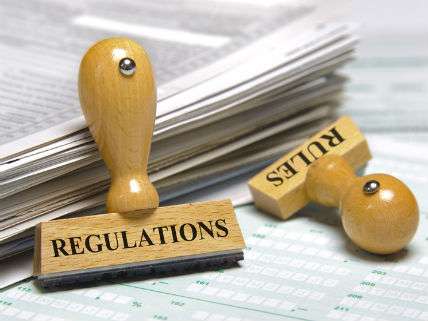Slow Economic Growth: It's the Regulations, Stupid!
Regulations multiply at record rates while productivity slows downs - coincidence?

It's the economy, stupid!, was the slogan devised for Bill Clinton by his campaign manager James Carville in the 1992 presidential race. The slogan kept the campaign focused on the financial and employment anxieties of Americans who had just gone through what, in the wake of the Great Recession, we would call a minor hiccup. New York Times economics columnist Eduardo Porter wonders why the post-Great Recession economy has been so sluggish, and especially why productivity growth has faltered. Porter cites the dire forecast of Lakshman Achuthan of the Economic Cycle Research Institute who argues that anemic labor force growth of half a percentage point plus productivity growth of half a percentage point "will push the economy ahead at the anemic pace of just 1 percent a year."
Porter, a convinced Keynesian, urges the government to print money, ah, "prepare for another bout of fiscal stimulus" to boost consumer demand as a counter for recessionary forces should they emerge. He cites Harvard economist Larry Summers as suggesting that the right policies could boost economic growth half of percentage point. It's not nothing, but it's far from the 3.4 percent per year growth rates the U.S. experienced in the 1990s. Is there anything that can be done that might boost economic growth to something like the boom years of the 1990s?
Porter does hit upon the right idea when he notes, "Eliminating onerous regulations — things like occupational licenses that restrict eligibility for a variety of jobs and overly tight zoning laws that prevent the building of new homes — would improve economic efficiency and equity." Yes, a thousand times, yes!
As the Competitive Enterprise Institute reports, "six of the seven record-high Federal Register annual page counts are attributable to President Barack." In fact, 2015 broke the record for number of pages in the Federal Register at 82,036 pages, more than 600 pages longer than the previous 2010 record. This accumulating pile of rules, regulations, and guidance has cut economic growth in 1980 by about 0.8 percent annually, according to a recent study by the Mercatus Center at George Mason University.
"The economy would have been about 25 percent larger than it was in 2012 if regulations had been frozen at levels observed in 1980," the Mercatus authors say. "The difference between observed and counterfactually simulated GDP in 2012 is about $4 trillion, or $13,000 per capita."
Another way to think about what an 0.8 percent lower growth rate means is to consider that from the trough of the Great Recession in 2009 when real U.S. GDP had fallen to $14.335 trillion until the first quarter of this year when it was $16.492 trillion implies a growth rate of 2.02 percent annually. If the growth rate had actually been 2.82 percent, U.S. GDP now would $17.415 trillion, about $1 trillion more than it is. If growth had increased at 3.4 percent per year (the 1990s rate) since 2009, U.S. GDP would now be $18.115 trillion.


Show Comments (74)